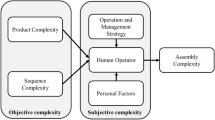Typical mechanical products can be assembled in various sequences of assembly operations. These sequences have high impact on the assembly time, machine utilization and even on the product quality. In order to select the best sequence of assembly operations, proper evaluation of the various sequences of assembly operations is required. This, in turn, requires the consistent evaluation of each assembly operation in the sequence. The assembly operations can be evaluated for various criteria, of which the operation difficulty is the most meaningful. This paper describes a methodology to analyse the assembly operations and calculates an operation's degree of difficulty using an expert system. This analysis consists of two steps: the first one identifies the main parameters that affect the assembly difficulty and assigns fuzzy triangular values to these parameters. The second step assigns weights to the parameters in order to maximize the agreement with a domain expert. The expert system analyses the difficulty of the assembly operation performed in two orientations: horizontal and vertical. The expert system then assigns a triangular fuzzy number as the aggregate measure of the operation's difficulty.
Similar content being viewed by others
References
Baldwin, D. F., De Fazio, T. L. and Whitney, D. E. (1991) An integrated aid for generating and evaluating assembly sequences for mechanical products. IEEE Transactions on Robotics & Automation, 7 (1), 78–94.
Boothroyd, G. (1987) Design for assembly—the key to design for manufacturing. International Journal of Advanced Manufacturing Technology, 2 (3), 3–11.
Bullinger, H. J. and Ammer, E. D. (1984) Computer-aided depicting of precedence diagrams—a step toward efficient planning in assembly. Computers & Industrial Engineering, 8 (3/4), 165–169.
De Fazio, L. T. and Whitney, D. E. (1987) Simplified generation of all mechanical assembly sequences. IEEE Journal of Robotics & Automation, 3 (6), 640–658.
De Fazio, L. T. and Whitney, D. E. (1989) Aids for the design or choice of assembly sequences, in IEEE International Conference on System, Man and Cybernetics, Nov., pp. 61–70.
Dubois, D. and Prade, H. (1987) Recent literature collected by Didier Dubois and Henri Prade. Fuzzy Sets and Systems, 24, 385–390.
Dubois, D. and Prade, H. (1988) Recent literature collected by Didier Dubois and Henri Prade. Fuzzy Sets and Systems, 26, 225–242.
Gaines, B. R. and Kohout, L. J. (1977) The fuzzy decade—a bibliography of fuzzy systems and closely related topics. International Journal on Man-Machine Studies, 9, pp. 1–68.
Homem de Mello, L. S. and Sanderson, A. C. (1988a) Planning repair sequences using the AND/OR graph representation of assembly plans, in IEEE International Conference On Robotics and Automation, 3, pp. 1861–1862.
Homem de Mello, L. S. and Sanderson, A. C. (1988b) Automatic generation of mechanical assembly sequences, Technical Report, The Robotics Institute, Carnegie Mellon University.
Homem de Mello, L. S. andSanderson, A. C. (1989a) Representations of assembly sequences, in Proceedings of the Eleventh International Joint Conference on Artificial Intelligence, 2, pp. 1035–1040.
Homem de Mello, L. S. and Sanderson, A. C. (1989b) A correct and complete algorithm for the generation of mechanical assembly sequences, in IEEE International Conference On Robotics and Automation, 1, pp. 56–61.
Kandel, A. and Yager, R. R. (1979) A 1979 bibliography on fuzzy sets, their applications and related topics, in Advances in Fuzzy Set Theory and Applications, Gupta, M. M. (ed.).
Kandel, A. (1986) Fuzzy Mathematical Techniques with Applications, Addison-Wesley, Reading, Mass.
Kochan, A. (1991) Boothroyd/Dewhurst—quantify your designs. Assembly Automation, 11 (3), 12–14.
Leaney, P. G. and Wittenberg, G. (1992) Design for assembling: the evaluation methods of Hitachi, Boothroyd and Lucas. Assembly Automation, 12 (2), 8–17.
Lee, K. and Gossard, D. C. (1985) A hierarchical data structure for representing assemblies: part 1. Computer Aided Design, 17 (1), 15–21.
Lee, K. and Ko, K. (1987) Automatic assembling procedure generation from mating conditions. Computer Aided Design, 19 (1), 3–10.
Lee, S. (1989) Disassembly planning based on subassembly extraction, in Proceedings of the Third ORSA/TIMS Conference on Flexible Manufacturing Systems, pp. 383–388.
Lin, A. C. and Chang, T. C. (1991) Automated assembly planning for 3-dimensional mechanical products, in Proceedings of the 1991 NSF Design and Manufacture System Conference, NSF, pp. 523–531.
Nevins, J. L. and Whitney, D. E. (1978) Computer controlled assembly. Scientific American, 238 (2), 62–74.
Sekiguchi, H. and Kojima, T. (1989) Study on automatic generation of assembly sequences. Annals of CIRP, 371–374.
Whitney, D. (1988) Manufacturing by design. Harvard Business Review, July/Aug., 83–91.
Author information
Authors and Affiliations
Rights and permissions
About this article
Cite this article
Ben-Arieh, D. Analysis of assembly operations difficulty: a fuzzy expert system approach. J Intell Manuf 4, 411–419 (1993). https://doi.org/10.1007/BF00123954
Issue Date:
DOI: https://doi.org/10.1007/BF00123954




